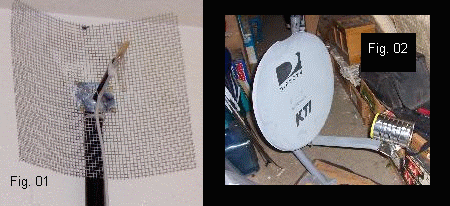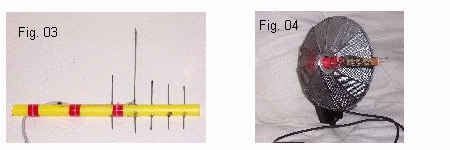|
Wi-Fi has really come the distance in just a few years, and
now with the 5.0GHz hittin the scene its like; there is no such
thing as 'long-distance' anymore. Old fashioned 'land lines'
seem to be dropping off from use and almost everyone has turned
to wi-fi or cell phones.
Dialup ISPs (Internet Service Providers) are suffering from
thousands of subscribers canceling their services, and turning
to wireless high bandwidth ISPs as a standard connection. Some
of the best on-ramps to the Net come from a cell phone, wireless
commercial hot-spots, cable connections, or even from satellite.
For years now; I have waited for the wi-fi "set-top-box"
to make its appearance from several different cell phone companies
and manufactures, but have realized that; dish and cable companies
(especially here in the west) dont want to see these wonderful
units in _any_ household.
The set-top-box uses a wi-fi signal to distribute and send
subscriptions of programing to a cell-phone type user account.
The user has the right to manage his or her Internet, Phone,
TV, and Home account(s) using a single cell phone. Blackberry
has really put some years into its security for all this, and
now everything is ready to go but; not everyone knows about it,
let alone can afford it.
If you are interested in the set-top-box from: Motorolla,
Microsoft, Verizon, AT&T, Sprint, or others... just download
e-book(#29): "My Digital Divide" - and see for yourself.
These units have been in successful operation for more than 4
years in over 6 countries: Austrailia, Germany, Switzerland,
Canada, England, Brazil, China, and in some testing areas of
the Northern United States.
Until people start doing something about their cable or satellite
habbits, I have decided to continue working on my wi-fi stuff,
and have made a few changes to my portable collection. Also,
I am going to be looking into the current N Band wireless (5.0
GigaHertz). This band is almost a standard and might get just
over 100K. Just last month; my city and county agencies addopted
the 5.0GHz (N-band) frequencies as a newer standard for all their
structured and mobile networks.

Using a few homemade 2.4GHz antennas... Fig. 01, 02, 03, and
04... I have found there to be certain uses for each of them.
On the first and second (01,02) antenna; I use them almost everyday,
and on some occations they help me verify DTV (Digital Broadcast
TV) channels and their direction. On the third one (03); I use
it for simple inside/outside reception, and on the last one (04);
its pocket-sized "foldout" portability lets me survey
a new area fast easy.
Antenna 02 is the 'ol coffee can model, and is mounted on
an older (Hughes/DTV) satellite dish. Both 01 and 02 are very
directional. They dont need electricity and have the abiltiy
to push/pull in signals 500-1000 times the norm. I have tested
them both to a range of 2-1/2 to 4 miles, or 10,000 - 25,000
feet. If I use a simple 2 GHZ 12vdc powered amplifier, the signal(s)
are amplified to a range of over 8 miles!

For antenna 03, i used the "paper-clip" style but
everything is 'doubled'. It has great perfomance and can be used
everywhere, and is limited to about 1 mile or 5,000ft. Antenna
04, was made like the 'paper-clip' version but, from a guitar
string and an old Kodak pocket-bulb-flash reflector (1959). It's
'fan folding" reflector is great for portable surveys (finding
hot spots and their direction). It has a standard range of about
2,000ft. or half a mile.
Each of these antennas can be made cheaply for less than $10
bucks, and no special tools are needed. The only trick; is to
be exact in your messurements for the elements, AND your antenna
wire. (the length of your antenna wire is also important and
has to be an 'equal sum' of its over all wavelength)
For example; if your antenna wave is 2.0Ghz then its wavelength
is just a bit longer (.42cm for each 1/4 wave) from a 2.4GHz
signal or wavelength at half a wave (5.23cm) (i use about
125 inches for my total wire length on all 2.4ghz connections...which
equals about 20 times the actual full wave) if you multiply
the waves or its length in an equal number, everything should
be fine. The same goes for the reverse if you are moving up to
the new 5.0ghz N-band...everything is cut in half, but equal.
For the new 5.0GHz frquencies, just make your messurements
to about 1.25cm to 1.35cm for a full 1/4 wave or you can just
continue using your old 2.4ghz antenna attached (usually 2.45cm
to 2.65cm) for a 1/8th wave at 5.0ghz...also, the (100K N-band)
5.0ghz wave is backwards compatible to the 2.4ghz (54K G-band)
waves, but only in one direction will you get the full 100K bandwidth.
NOTE: Your standard 'consumer' wireless wi-fi transmissions
from a laptop or or any other device is usually under 1 watt,
but your average microwave oven puts-out over 1,000 watts at
4 or 5 GHz to cook your meat! So be careful when experimenting
with high voltages and freqs please! Also, be sure to turn-off
any bluetooth devices while using 802.11g; they too can cause
unwanted wifi errors.
Standard performance or consumer G Band Wi-Fi (2.4 GHz) amplfiers
can be bought online for around $50-$100 dollars (commercial
high power versions can be as much as $1,000 each), or you might
find them cheaper at US electronic supply houses listed in some
of the links below. If you respect the power; or are one with
the electron, then you might want to build something of your
own.
-CopyCat
===================================
Useful Links:
Standard
and avanced information on some of the more common wifi and its
uses (Wiki) Homemade WiFi Antennas - Paper Clip, Coffee Can,
dipole, dish, etc...(Wiki)
A.R.R.L - Ameture
Radio Relay League - TV, Radio, and Communications documents,
diagrams, and cross-references from over 50 years of electronics,
plus news posts, and blogs from hobbiests around the world. Years
of public trust in HAM radio, and the like.
----------------------------------------------
Recover From A Bad Flash - This is the details
for reviving a dead or "bricked" router with DD-WRT
HairyDairy Maid's current JTAG Utility (ZIP)
- He made a nice tutorial a few years back (pdf) on reviving
dead "Broadcom" devices like the LinkSys routers or
any device that uses an electronic JTAG port. This is a well
known method and advanced technical knowledge is required if
you want success. Official support is limited to the GNU community.
-----------------------------------------------
More information on popular router software:
Wiki DD-WRT - A free GNU Linux firmware operating
system for those reviving an old, dead or bad router. (for advanced
users and programmers...mostly).
NOTE: some modifications to a wifi device may and will void any
or all manufacture's warranty if damaged, and the costs for repairs
can be more than its worth!
----------------------------------------------
Homemade WiFi Amplifiers - some useful tips
and information.
Long
Distant WiFi - more useful stuff on long range reception
(Wiki)
************************************************************
This Project will be compiled for
download soon. Signup for the CopyCat Newsletter to keep up with
the new stuff.
************************************************************
|
